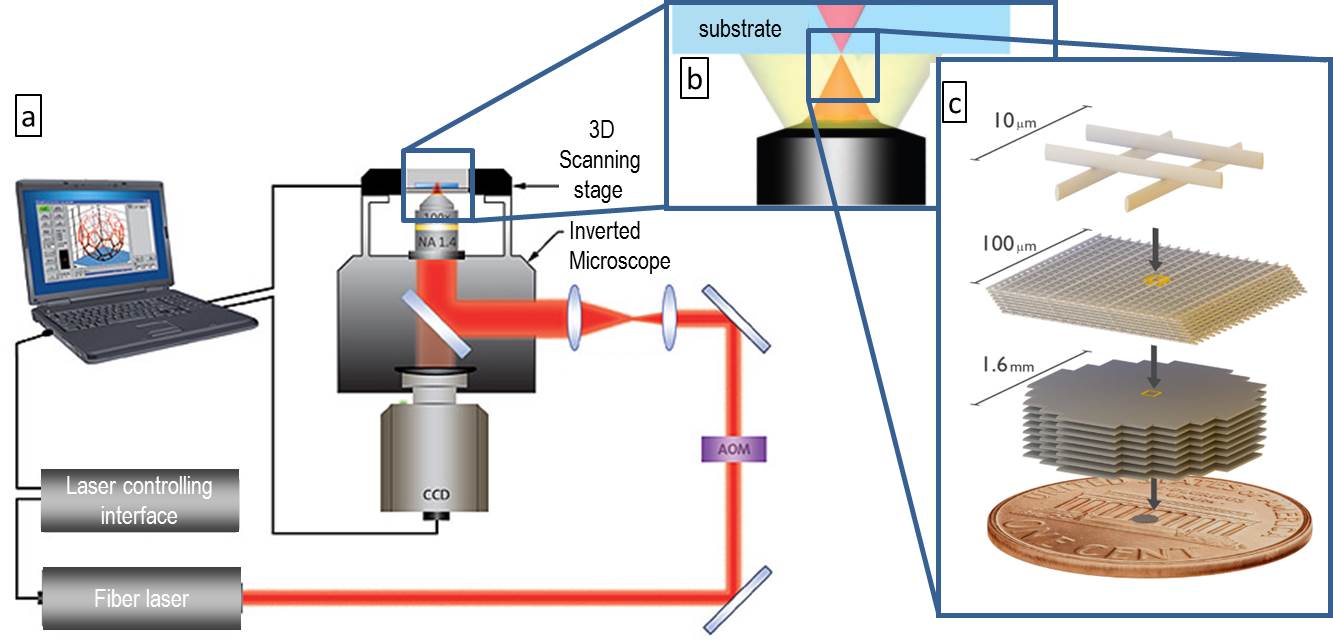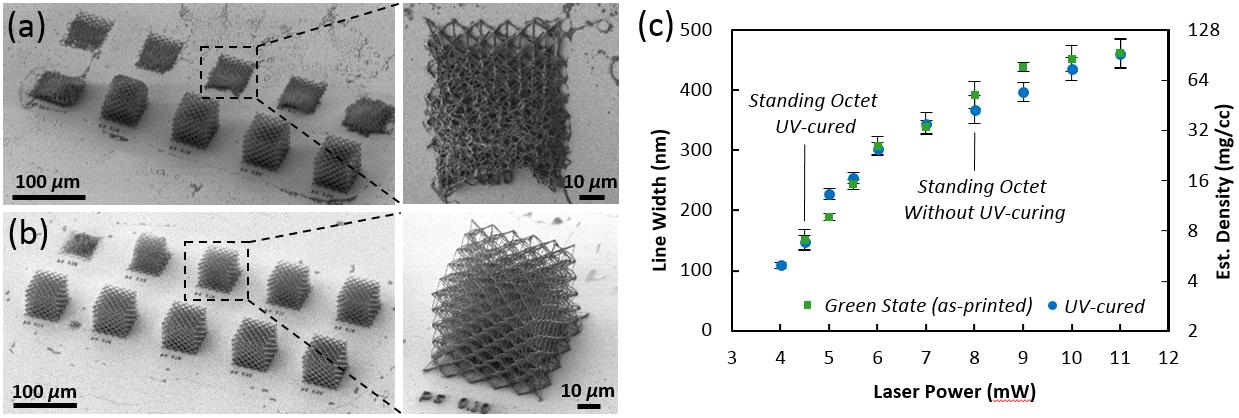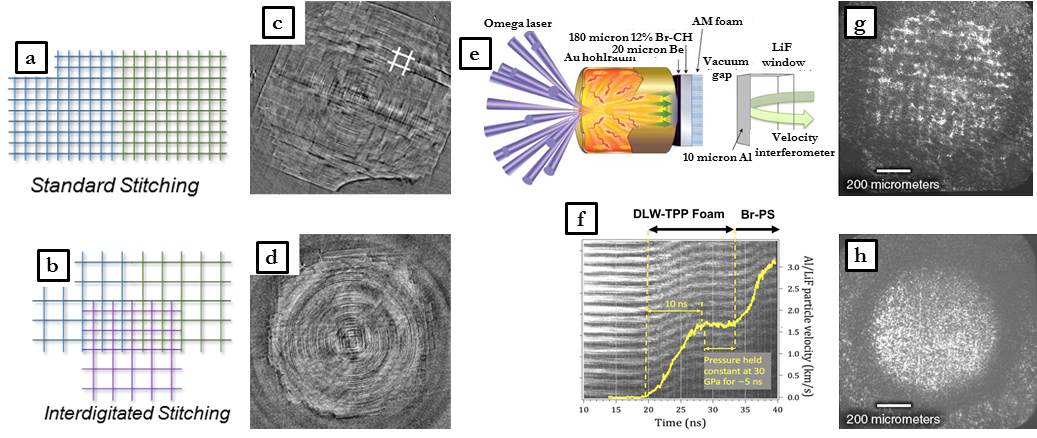Juergen Biener (15-ERD-019)
Abstract
Monolithic porous bulk materials have many promising applications, ranging from energy storage and catalysis to high-energy-density (HED) physics. For this project we used direct laser writing two-photon polymerization (DLW-TPP), a three-dimensional (3D) printing technique with sub-micron resolution, to develop porous graded-density materials with deterministic anisotropic architectures. The materials have been tested for their ability to shape plasma-piston drives during ramp compression of materials under HED conditions created at the University of Rochester's OMEGA Laser Facility. The 3D-printing approach allows for tooling-free integration of 3D-printed target components thus greatly reducing the cost while improving throughput and reproducibility. To achieve our goal we used a two pronged approach. On one side, we further developed the DLW-TPP technique to enable printing of millimeter-sized highly porous microlattices (down to 0.05 gram-per-cubic-centimeter) with controlled multiscale architecture and macroscopic shape. This was achieved by developing (1) new functional photoresists (PRs) for DLW-TPP, (2) a post-print ultra-violet curing method to improve the mechanical properties of the printed structure without decreasing resolution, and (3) stitching techniques that enabled us to fabricate millimeter-sized samples that are extremely uniform in terms of local density. In our second approach, we explored the use of 3D-printed polymer parts as sacrificial templates for the fabrication of pure carbon and gold microlattices. Hierarchical structured porous carbon materials were prepared by either direct nickel-catalyzed low-temperature carbonization of the polymeric template or by infiltration of 3D-printed polymer templates with a resorcinol-formaldehyde (RF) sol-gel precursor solution, followed by supercritical drying and selective carbonization of the RF gel while simultaneously thermally decomposing the polymeric template. Uniform and conformal gold coatings were fabricated by electroless gold plating on 3D-printed polymeric templates surface-functionalized by an acid treatment. Performance tests at the Omega Laser Facility showed that the materials developed in this project outperformed traditional graded-density foam reservoirs fabricated from low-density bulk materials by using time consuming and expensive machining and assembly techniques.
Background and Research Objectives
Monolithic anisotropic low-density porous materials with spatially controlled density profiles, feature size, and morphology have recently attracted much interest due to their many potential applications, ranging from high-energy-density physics and shock energy absorption to catalysis, energy storage, and conversion. However, despite the progress that has been made in nanomaterials synthesis and in the field of engineered microlattices, there still remains a length-scale gap that separates true nanomaterials from engineered microstructures, thus preventing materials scientists from taking full advantage of engineered low-density porous materials. The objective of this project was to bridge this length-scale gap by (1) further pushing the boundaries of ultra-high resolution additive manufacturing (AM) techniques like direct-laser-writing two-photon polymerization (DLW-TPP) toward higher resolution and larger samples; (2) developing photoresists (PRs) with built-in porosity and length-scale control at the sub-100-nm length scale); and (3) combining AM with nature’s principles of self-organization, self-assembly, and templating. Specifically, the project aimed at developing monolithic millimeter-sized graded low-density carbon-based foam materials that offer deterministic control over uniaxial density profiles, thus enabling control over plasma-piston drives in laser-driven ramp-drive materials strength tests.
Scientific Approach and Accomplishments
In recent years, AM techniques, including projection micro-stereolithography (Zheng 2014; Zheng 2016; Ge 2016) and direct ink writing (Rodriguez 2016, Zhu 2015; Duoss 2014; Lewis 2006) have been used to fabricate engineered microlattices with deterministic control over 3D morphology. In this project we exploited the unparalleled resolution of DLW-TPP (Malinauskas 2013; Fischer 2013) to fabricate millimeter-sized graded-density (0.06 to 0.6 gram per cubic centimeter) foam parts with sub-micron features, precisely controlled macroscopic dimensions, and engineered spatially non-uniform architectures. DLW-TPP uses a femtosecond pulsed laser focused through a high numerical aperture (NA) objective to locally drive polymerization chemistries within TPP responsive PRs (Figure 1a). 3D printing is enabled by moving the laser focal point through the PR, either by translation of the substrate around a stationary beam or by moving the laser beam by galvo scanners on a stationary substrate. The latter enables faster printing speeds (in excess of 10 mm per second), which enables the fabrication of millimeter-sized samples with submicron features whose total written path length can easily exceed 10,000 meters.
Achieving sub-500 nm resolution requires the use of high-NA (>1.3) objectives, ideally in combination with the dip-in laser lithography (DiLL) technology (Figure 1b) where the objective is emerged in a refractive index (RI) matched PR. However, high-NA objectives (Sun 2004; Zhou 2015) also severely restrict the accessible range of galvo laser scanners to approximately 100-by-100 µm2 because of spherical aberrations and vignetting effects. Time-efficient microstructuring over a large area thus requires a repetitive two-step sequence of fast galvo-printing followed by stage-movements, a process commonly referred to as stitching (Figure 1c). While enabling the fabrication of macroscopic objects, stitching frequently causes structural defects due to alignment errors that modify the local density along the stitching interfaces that can seed instabilities in material strength tests.
To enable 3D printing of millimeter-sized foam targets for material strength tests at the University of Rochester's Omega Laser Facility, we therefore developed (1) new functional PRs for DiLL DLW-TPP, (2) a post-print ultraviolet (UV) curing method to improve the mechanical properties of printed structures without affecting resolution, and (3) techniques that allowed us to fabricate extremely uniform samples in terms of lateral density variations. The polymeric foam parts fabricated by DLW-TPP were either directly used as target components or further modified by templating and coating approaches.
Development of New PRs for DLW-TPP
DLW-TPP combined with DiLL enables 3D printing of tall (several millimeters) ultra-high resolution (feature size below 500 nm) structures (Figure 2). In DiLL, the microscope lens is in direct contact with the PR that needs to be RI-matched to the objective lens (RI = 1.52). Even small deviations of the RI of the PR from this value significantly affect the quality of the printed structure due to the emergence of spherical aberrations. We discovered that RI-matched customized TPP photoresists can be prepared by blending aromatic monomers with different polarizabilities, for example bisphenol acrylate (BPA, RI ~ 1.55) and dipentaerythritol pentaacrylate (DPEPHA, RI ~ 1.49) (Figure 2a). Using this approach, we developed several RI-matched functional TPP PRs, including a higher viscosity PR for larger samples, a “porous” PR, and a high atomic number doped PR (Figure 2b/c).
Post-Print UV Curing
Polymer parts fabricated with DIW-2PP are only partially cured. As a consequence, their mechanical properties, (i.e., modulus and ultimate strength) are lower than they would be if cross-linked to the maximum extent. In the case of ultra-low-density parts, this can lead to catastrophic structural failure. To increase the cross-linking density and improve mechanical properties, we developed a post-print curing method based on UV-driven radical generation. This allowed us to fabricate the same structure at lower laser power, which in turn decreased the resulting line width and the density of the parts (Figure 3).
Optimization of Stitching
While the extremely high galvo-mode DLW-2PP printing speeds enable the fabrication of millimeter-sized samples with submicron features, the technique also requires that the structure be stitched together from individually fabricated 100-by-100 µm2 blocks. To fabricate macroscopically uniform, low-density porous samples, the alignment error of the individually fabricated blocks should be smaller than the structural feature size. The commercial printer used in this project has a long-range motor stage with a measured positional accuracy of 1.5 µm. While acceptable for many applications (Nelson 2016), this tolerance is nearly an order of magnitude larger than the width of the lines used to write the low-density structures investigated in this project. Standard block-to-block stitching (Figure 4a) can result in discontinuous structures across stitching seams, thus causing lateral density fluctuations (Figure 4c) and mechanical failure. A major breakthrough in this project was the development of a new fault-tolerant and easy-to-implement universal stitching protocol, NanostitchTM. It mitigates the limited precision of the motor stage and can be used as a general processing strategy for macroscopic ultra-high-resolution DLW-TPP parts.
Our new stitching technology is based on fully interdigitated blocks by first printing a set of log-pile blocks with twice the desired pitch (half density), and then printing a second set of blocks, offset in both the x and y axes by 0.5*dimensions of each block plus 0.5*pitch (Figure 4b). Although individual line misalignment still occurs along the stitch seams, the stitch seams are now buried in the center of each interdigitated block. Every other line contains a potential misalignment, resulting in a more homogeneous and crack resistant structure on both the micro- and macroscale. The improved homogeneity is confirmed by the largely featureless x-ray computer tomography images compared to those obtained from samples prepared by standard stitching (Figure 4c,d).
Ramp-compression experiments (Figure 4e) at the Omega Laser Facility were performed quarterly over a period of 1.5 years to evaluate the performance of DLW-TPP foams prepared using various stitching strategies. This experimental setup relied on a complex package of materials consisting of several components, including a low-density foam reservoir that has been demonstrated to temporally shape and smooth plasma-compression drives (Prisbrey 2012; Smith 2007; Park 2010). At densities of 0.07 g/cm3, the stitching pattern had little effect on the VISAR-derived temporal profile of the compression (Figure 4f). The particle-velocity profiles are characterized by an initial smoothly rising ramp profile, an extended five-nanosecond-long hold period, and a second ramp compression wave to peak velocity. However, two-dimensional velocity maps from tests using foam reservoirs prepared with the standard stitching protocol revealed that the density fluctuations along the stitching seams (Figure 4c) induced a laterally nonuniform pressure drive, as evidenced by the individual “blocks” imprinted on the target velocity map (Figure 4g). Interdigitated stitching (Figure b,d,h) dramatically improved the material's uniformity and made the resulting pressure drive more even.
Templating Approach
In our second approach, we used the printed polymer parts as sacrificial templates for the fabrication of pure carbon and gold microlattices (Figure 5).
In one approach, we developed 3D graphene (Figure 5a) foams with a unique double tubular morphology and densities as low as 10 mg/cm3 by nickel-catalyzed conversion of DLW-TPP polymer foams. The smooth and conformal nickel coating that determines the gap between the inner and the outer tube was applied via electroless plating. Due to its unique morphology, the resulting 3D graphene foam is stiffer than any other low-density carbon foam. 3D carbon foams were also fabricated by infiltrating both projection microstereolithography (PµSL) and DLW-2PP polymer microlattices with resorcinol-formaldehyde (RF) gel precursor solutions, followed by supercritical drying and selective carbonization of the templated RF foam while simultaneously decomposing the PR template (Figure 5b,c). Finally, Au-polymer hybrid microlattices (Figure 5d) and freestanding Au microlattices were fabricated by electroless plating of PµSL and DLW-2PP polymer microlattices. It was found that uniform and conformal Au coatings can be fabricated by Au electroless plating if the surface of the polyacrylate templates is first functionalized by an acid treatment to improve the adhesion of the Au nanoparticles that serve both as seeds and catalyst.
Impact on Mission
Our work with accelerated development of multiscale materials opened a new chapter in materials science by establishing deterministic control over morphology, porosity, and composition by five orders of magnitude, from nanoscale features to macroscopic dimensions on the millimeter-length scale. Our research supports the Lawrence Livermore National Laboratory’s core competency in additive manufacturing and addressed the science needs of Laboratory’s Stockpile Stewardship and Energy and Climate mission focus areas.
The successful tooling-free integration of low-density porous materials into a complex package of materials consisting of several components provides a glimpse into the future of high-energy-density (HED) physics target fabrication. Tooling-free integration of low-density porous materials is expected to greatly improve the reproducibility of HED/ICF target fabrication. Deterministic control over density profiles enables realization of new concepts for mitigating hydro-instability growth in HED/ICF experiments. The technology also greatly reduces the time associated with the design–build–test cycle, from several months to a few hours. Beyond the Laboratory's specific target application, the progress made in this project is expected to lead to a paradigm shift in the field of hierarchically structured porous materials by creating a pathway toward porous structures that mimic nature’s functional filtration organs such as kidneys and liver.
James Oakdale, who was hired for the project, received the 2017 Materials Science Division postdoc award for his contributions to this project.
Conclusion
The improvements in DLW-TPP achieved in this project open the door to use engineered AM polymer foams with deterministic 3D morphology (from nanoscale building blocks to macroscopic dimensions) as sacrificial templates. Ultimately, this work will result in a universal templating capability for accelerated development of foam components of any shape, composition, density, and architecture. However, the experiments performed in this project also revealed several PR-related challenges linked to feature size, mechanical stability, coating uniformity, and template removal that need to be overcome for the technology to progress. Future work will develop the underlying science and fabrication capabilities enabling the development of PRs for sacrificial templates that (1) combine high resolution with good mechanical properties, (2) provide tailored surface functionalization for uniform and conformal coatings via atomic-layer deposition and electroless plating, and (3) can be removed without causing deformation or cracking (e.g., by stimulated low-temperature depolymerization). Several HED physics-related applications already emerged, ranging from tooling-free fabrication and integration of high-atomic-number hohlraum foam liners for high-performance Inertial Confinement Fusion experiments at the National Ignition facility, to a new experimental platform that enables testing of material properties under extreme conditions.
References
Duoss, E. B., et al. 2014. "Three-Dimensional Printing of Elastomeric, Cellular Architectures with Negative Stiffness." Advanced Functional Materials 24: 4905—4913. doi: 10.1002/adfm.201400451.
Fischer, J. and M. Wegener. 2013. "Three-Dimensional Optical Laser Lithography Beyond the Diffraction Limit." Laser and Photonics Reviews 7: 22—44. doi: 10.1002/lpor.201100046.
Ge, Q., et al. 2016. "Multimaterial 4D Printing with Tailorable Shape Memory Polymers." Scientific Reports 6: 31110. doi: 10.1038/srep31110.
Gesser, H. D. and P. C. Goswami. 1989. "Aerogels and Related Porous Materials." Chemical Reviews 89: 765—788. doi: 10.1021/cr00094a003.
Gibson, L. J. and M. F. Ashby. 1997. Cellular Solids: Structure and Properties. 2nd. ed. Cambridge, UK: Cambridge University Press. doi: 10.1017/CBO9781139878326.
Lewis, J. A. 2006. "Direct Ink Writing of 3D Functional Materials." Advanced Functional Materials 16: 2193—2204. doi: 10.1002/adfm.200600434.
Malinauskas, M., et al. 2013. "Ultrafast Laser Nanostructuring of Photopolymers: A Decade of Advances." Physics Reports 533 (1): 1—31. doi: 10.1016/j.physrep.2013.07.005.
Nelson, G., et al. 2016. "Three-Dimensional-Printed Gas Dynamic Virtual Nozzles for X-ray Laser sample delivery." Optics Express 24 (11):11515—11530. doi: 10.1364/OE.24.011515.
Oakdale, J. S., et al. 2016. "Post-print UV curing method for improving the mechanical properties of prototypes derived from two-photon lithography." Optics Express 24:27077-27086.
Oakdale, J. S., et al. 2017. "Direct Laser Writing of Low-Density Interdigitated Foams for Plasma Drive Shaping." Advanced Functional Materials:1702425. doi: 10.1002/adfm.201702425.
Park, H.-S., et al. 2010. "Viscous Rayleigh–Taylor Instability Experiments at High Pressure and Strain Rate." Physical Review Letters 104:135504. doi: 10.1103/PhysRevLett.105.179601.
Prisbrey, S. T., et al. 2012. "Tailored Ramp-Loading via Shock Release of Stepped-Density Reservoirs." Physics of Plasmas 19. doi: 10.1063/1.3699361.
Rodriguez, J. N., et al. 2016. "Shape-Morphing Composites with Designed Micro-Architectures." Scientific Reports 6:27933. doi: 10.1038/srep27933.
Smith, R. F., et al. 2007. "Graded-Density Reservoirs for Accessing High Stress Low Temperature Material States." Astrophysics and Space Science 307 (1-3): 269–272. doi: 10.1007/s10509-006-9231-8.
Sun, H.-B. and S. Kawata. 2004. "Two-Photon Photopolymerization and 3D Lithographic Microfabrication." NMR 3D Analysis: Photopolymerization, 169–273. Springer, Berlin.
Zheng, X., et al. 2014. "Ultralight, Ultrastiff Mechanical Metamaterials." Science 344 (61909): 1373—1377. doi: 10.1126/science.1252291.
——— 2016. "Multiscale Metallic Metamaterials." Nature Materials 15: 1100—1107. doi: 10.10388/NMAT4694.
Zhou, X., Y. Hou, and J. Lin. 2015. "A review on the processing accuracy of two-photon polymerization." AIP Advances 5:030701.
Zhu, C., T. Y-J Han, E. B. Duoss, A. M. Golobic, J. D. Kuntz, C. M. Spadaccini, and M. A. Worsley. 2015. "Highly compressible 3D periodic graphene aerogel microlattices." Nature Communications 6:6962.
Publications and Presentations
Oakdale, J. S. 2017. "HED Physics Target Fabrication by Additive Manufacturing." Target Fabrication Meeting. Las Vegas. LLNL-PRES-725758.
Oakdale, J. S., et al. 2016. "Post-print UV Curing Method for Improving the Mechanical Properties of Prototypes Derived from Two-Photon Lithography." Optics Express 24 (24):27077–27086. doi: 10.1364/OE.24.027077. LLNL-JRNL-702799.
——— 2017. "Direct Laser Writing of Low-Density Interdigitated Foams for Plasma Drive Shaping." Advanced Functional Materials 27 (43). doi: 10.1002/adfm.201702425. LLNL-JRNL-730683.










